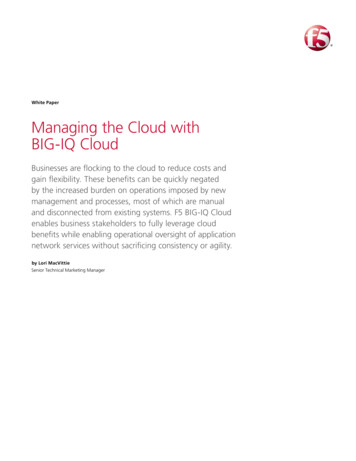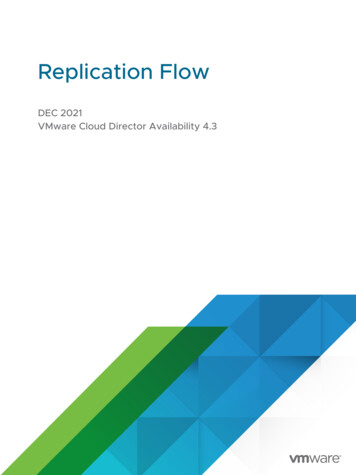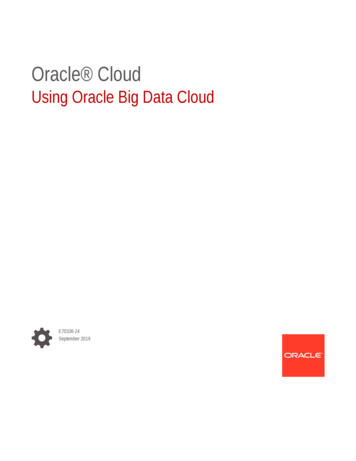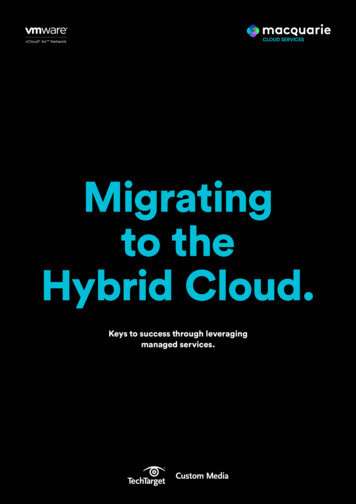
Transcription
White PaperManaging the Cloud withBIG-IQ CloudBusinesses are flocking to the cloud to reduce costs andgain flexibility. These benefits can be quickly negatedby the increased burden on operations imposed by newmanagement and processes, most of which are manualand disconnected from existing systems. F5 BIG-IQ Cloudenables business stakeholders to fully leverage cloudbenefits while enabling operational oversight of applicationnetwork services without sacrificing consistency or agility.by Lori MacVittieSenior Technical Marketing Manager
White PaperManaging the Cloud with BIG-IQ CloudContentsIntroductionThe New Data Center Management Model: FrameworksF5 BIG-IQ Cloud334The BIG-IQ Cloud Platform5The BIG-IQ Cloud API6BIG-IQ Cloud Connectors7The BIG-IQ Cloud Portal10BIG-IQ Cloud iApps Lifecycle Management11BIG-IQ Cloud Service Health Monitoring12Conclusion122
White PaperManaging the Cloud with BIG-IQ CloudIntroductionThe adoption of cloud solutions continues unabated. As enterprise organizationshave continued to expand their use of cloud strategies, they have enjoyed relatedbenefits, particularly that of agility. An October 2012 survey1 conducted on behalf ofRedwood Software reported that 63 percent of enterprises that have implementedcloud solutions report an improvement in agility for supporting the needs of thebusiness. When this benefit is coupled with reduced costs, it is inevitable that moreapplications will be deployed within cloud computing environments in the future.Thus IT practitioners must adapt to this new paradigm and support both on- andoff-premises cloud deployments, as well as maintain existing—and likely moretraditional—application deployments. Doing so introduces complexity, as applicationnetwork services in off-premises locations tend to be managed via processes andtoolsets completely disconnected from those for managing on-premises services.The complexity of managing application network services through multiple consoles,APIs, and processes increases the potential for error and may offset the gain inproductivity arising from the use of a commoditized cloud infrastructure.IT must also determine how best to support elasticity and new architectural modelsthat span both on- and off-premises cloud computing environments. Hybrid cloudmodels are increasingly popular, with both on-demand capacity (also known ascloud bursting) and split-architecture applications ranking high on the list of usesdesired by IT and business stakeholders2. Yet the requirement to use cloud providerspecific APIs, frameworks, and management consoles to manage performance,scale, and security policies and practices is problematic.“Organizations that can bridgehyper-hybrid clouds with theircore systems will be at theforefront to elevate businessperformance with the nextwave of digital innovation.”—Tech Trends 2012: Elevate ITfor Digital Business, DeloitteThe challenge before IT, then, is how to enable governance of security, performance,and scalability policies across multiple environments managed using differentparadigms. Coupled with this is the pressure to do more with less: to automatedeployment and delivery processes in order to become as responsive as possible insupport of increasingly agile business models.The New Data Center Management Model: FrameworksUnifying application network services across both the cloud and the data centerenables IT operations to automate deployment processes, a strategy that improvesproductivity, reduces errors, and speeds deployments for business constituents.1 iness-processes2 In-session poll of hybrid cloud session at Gartner Data Center Conference 20123
White PaperManaging the Cloud with BIG-IQ CloudRedwood Software found in its survey that 79 percent of enterprises implementingprocess automation experienced time savings, while 69 percent claimed improvedproductivity.The time and effort required to implement a cross-cloud solution can be daunting.Virtualization-specific solutions work well for private (on-premises) cloud deploymentsbut rarely extend to encompass public (off-premises) clouds unless the public cloud,too, is based on the same virtualization technology. While this is a viable solution,it limits the choice of cloud providers and may not be acceptable to businessconstituents. OpenStack, considered a viable alternative that could address thisgap, requires skills that operations may or may not have. Too, the fledgling openstandards contender in the burgeoning cloud management platform market is stillmaturing, and its application network services remain nascent. Yet the need existsnow to extend enterprise-class application network and delivery services into thecloud in a consistent, unified manner—whether that cloud remains on the premisesor extends beyond the data center.F5 addresses that need with F5 BIG-IQ Cloud. Based on an extensible platform,BIG-IQ Cloud provides a framework for orchestrating the application networkservices provided by F5 BIG-IP Application Delivery Controllers (ADCs) in bothpublic and private clouds. BIG-IQ Cloud facilitates federating application networkand delivery services across clouds, regardless of their underlying network standardsand management frameworks, unifying management and exposing a single,consistent view of the services required to deliver fast, secure, and scalableapplications.F5 BIG-IQ CloudBIG-IQ Cloud is a comprehensive application network services management solution.It is designed to improve operational consistency by extending enterprise-classapplication delivery services into both on- and off-premises cloud environments. Itdoes so while also enabling the service automation and orchestration that result inconsistent, repeatable, and fast application deployments, regardless of location.BIG-IQ Cloud also enables integration with cloud management platforms, offeringthe ability to automate application deployment provisioning from end to end,including critical application network services like scalability, application routing,application-appropriate monitoring, security, and optimization.4
White PaperManaging the Cloud with BIG-IQ CloudBIG-IQ Cloud enhances cross-environment strategies such as cloud bursting andsplit-application architectures by supporting gateway capabilities that bridgemanagement frameworks and delivering a single console from which to managethe entire application lifecycle.The BIG-IQ Cloud management platform comprises multiple components: iApps Lifecycle Management Provider and tenant self-service web application portals The BIG-IQ Cloud Connector plug-in for connecting to private cloudorchestrators, e.g., to VMware vCloud Director and VMware vCloudNetworking and Security The BIG-IQ Cloud Connector for connecting to public cloud providers,e.g., Amazon Web Services (for cloud bursting) Service health and performance monitoring The BIG-IQ Cloud REST APIBIG-IQ Cloud PortalVEProvider PortalBIG-IQCloudBIG-IQ Cloud PortalTenant c CloudBIG-IQ CloudREST APIData Center 1Third-Party CloudOrchestrators(VMware vCloud Director)(Amazon Web Services)Data Center 2Data Center 3Data Center 4Figure 1: F5 BIG-IQ Cloud components integrate and collaborate to provide consistent,cross-environment management of application network services.The BIG-IQ Cloud PlatformThe BIG-IQ Cloud platform provides the core services necessary for managingapplication-specific services. As part of the platform, BIG-IP device inventoryand control extend to BIG-IP devices in all forms to provide platform information,5
White PaperManaging the Cloud with BIG-IQ Cloudsoftware versions, registration keys, module status, and other device-specificoperational data. The platform also enables analysis of historical data for capacityplanning, service contract management, performance monitoring of SSLtransactions, and distributed configuration management.BIG-IQ Cloud responsibilitiesThe BIG-IQ Cloud platform consolidates a variety of management, administration,and connectivity tasks into one point of control and a single pane of glass. Fromthis platform, IT can manage: Cloud bursting—Gain on-demand use of public cloud resources withmanagement of cloud-deployed BIG-IP virtual editions and integrationwith public cloud APIs. Self-service application deployment—Reduce application networkservice provisioning time to minutes from weeks. Application cataloging for service providers—Monetize applicationservice delivery by categorizing application network services per servicelevel agreements. Tenant application access—Offer a self-service application networkservice portal for tenant use. Orchestrator integration—Enable self-provisioning of application networkservices with northbound integration with VMware vCloud Networking andSecurity and VMware vCloud Director. Solution racking and licensing—Centralize deployment and managementof BIG-IP devices across environments. Performance and health monitoring—Access statistical health andperformance data for decision-making and troubleshooting.The BIG-IQ Cloud APIVia the BIG-IQ Cloud API, application network services are abstracted and exposedto consumers, allowing for direct interaction or integration with software-defineddata center (SDDC) orchestration solutions such as VMware vCloud Director.The BIG-IQ Cloud API enables hybrid cloud implementations to provide a variety ofcross-environment architectures and operating models, including cloud bursting andsplit-application architectures. BIG-IQ Cloud Connectors are built upon the BIG-IQCloud API and enable management of BIG-IP devices in cloud environments. This6
White PaperManaging the Cloud with BIG-IQ Cloudallows tenants to leverage cloud-hosted resources in a manner consistent withoperational and business policies governing performance, availability, and security.Organizations building custom management systems or desiring integration withother cloud management platforms also can use the BIG-IQ Cloud API to integrateBIG-IP application network services.The BIG-IQ Cloud API is part of BIG-IQ Cloud. As a REST API exposed through port443, it enables a robust set of management and operational functions, fromlicensing to tenant service instance management.REST API CategoryFunctionalityProvider interfaceLicensing functionalityConnectorCreate custom cloud connections with third-party cloudorchestratorsTenantCreate, modify, and delete tenantsiApps Management ServiceCreate, delete, and retrieve statistics and health ofapplication servicesTenant ServicesCreate, delete, and retrieve tenant service instancesFigure 2: The BIG-IQ Cloud API makes it easy to perform a variety of management andoperational functions.BIG-IQ Cloud ConnectorsBIG-IQ Cloud Connector is a plug-in that allows users to connect to cloudorchestration engines such as VMware vCloud Director or Amazon EC2 andmanage application-related network services, including application provisioningand application health monitoring.BIG-IQ Cloud Connectors for VMware enable IT infrastructure administrators andapplication owners to apply application network services using a single managementinterface in vCloud Director or vCloud Networking and Security.7
White PaperManaging the Cloud with BIG-IQ CloudProvider PortalTenant PortalShared Management PlaneInfrastructurePolicyData Center andSecurity PolicyVM VM VMHypervisorApplicationDelivery PolicyVECloudManagementPlatformsBIG-IQCloudFigure 3: BIG-IQ Cloud enables integrated management of the application networkservices required to deliver applications in the cloud.Administrators register services and the associated service templates along withthe clusters being served with the vCloud environment via the UI or API. Servicesare selected when an organizational virtual data center (VDC) is created, and theseservices will automatically be available when a new vCloud Networking and SecurityEdge Gateway is created in that VDC. Services and templates are then selected bythe tenant during the provisioning process. Only optional parameters need to bespecified by the tenant, as all other relevant application networking serviceconfiguration is specified in the template.By exposing only a few parameters to the tenant and encapsulating most of theconfiguration within the F5 iApps Templates of BIG-IQ, the provisioning processcan be dramatically shortened to a few hours. Additionally, basing deployments onexisting iApps Templates ensures consistent service definitions and mitigates thepossibility of introducing errors through misconfiguration.8
White PaperManaging the Cloud with BIG-IQ CloudFigure 4: Packaged integration with VMware vCloud Director and vCloud Networking andSecurity enables seamless provisioning via a unified management console, regardless of thenumber of tenants involved or how different the needs of each.Similar pre-packaged integration is currently available for Amazon EC2 to supporteffective cloud bursting and economic cloud-bursting architectures with the abilityto manage from a single console.BIG-IQ Cloud discovers virtual editions of BIG-IP ADCs that are running in differentclouds via cloud connectors. It can then manage, monitor, and configure thesevirtual editions as part of the overall BIG-IP ADC fabric. BIG-IQ Cloud Connectorsenable tenants to target applications to run in private, public, or hybrid clouds,delivering the ability to create secure, accelerated tunnels between clouds forbursting and on-demand capacity architectures. Since that capacity is consistentlymanaged on top of the ADC fabric, application service owners gain confidencethat their network topology, health monitors, and application delivery integrationexists on each cloud endpoint.BIG-IQ Cloud customers can also leverage the REST API to build custom connectorsfor their existing cloud orchestration platforms.9
White PaperManaging the Cloud with BIG-IQ nectorsREST APIPublic Cloud Control SessionSecure Control SessionMultiple-TenantPublic CloudSecure Data SessionFigure 5: The F5 BIG-IQ Cloud Connector architecture shortens the provisioning process forapplication delivery via both private and public clouds.The BIG-IQ Cloud PortalThe BIG IQ Cloud portal provides a user interface for provisioning virtualized networkservices such as high availability and web acceleration. The BIG-IQ Cloud portalcan automatically discover iApps deployed for BIG-IQ Cloud on BIG-IP devices andcreate a catalog that can be customized to support a variety of tenants. This allowsadministrators to provision a complete set of application network services alongwith each application, ensuring that the applications are operational in minutes aswell as forming the foundation for tenant self-service deployment.The BIG-IQ Cloud portal offers both a provider and a tenant view. Views offera catalog of network services and enable tenants to self-provision applicationnetwork services appropriate to their business requirements. This capability reducesprovisioning time from weeks to minutes, eliminating lengthy delays that impedebusiness flexibility. Each view exposes only specified services; application networkservices exposed to the tenant are controlled through role-based access control(RBAC) services.The BIG-IQ Cloud portal allows management of: Catalog—Provide a list of available deployments comprising an applicationand its associated application network services. Application—Obtain the holistic view of a specific application deployment. Tenant—Administer access and services for business or operationalstakeholders responsible for deploying applications.10
White PaperManaging the Cloud with BIG-IQ Cloud Cloud Connector—Enable integration with third-party orchestrators andcloud management frameworks. Device—Track, configure, and update BIG-IP physical or virtual devices.Only applications and BIG-IQ Cloud Connectors are accessible to tenants. All otherelements are available only to the provider. In addition, tenants are bound bythe application parameters specified by the provider upon creation of the iAppsTemplate. For example, one tenant may see only HTTP applications while anothermay be allowed HTTP and HTTPS (SSL).This simplifies the deployment of application network services by reducing thenumber of parameters required and enabling providers to ensure consistent basedeployments appropriate for their environments. For instance, providers can specifynetwork and application security constraints that protect both the provider and thetenant from attacks.Monitoring is provided to tenants as a service, offering visibility into the health andperformance of the infrastructure and cloud connections. This improved visibilityarms tenants with the data necessary to establish the appropriate delivery policiesfor elasticity and improved use of resources.BIG-IQ Cloud iApps Lifecycle ManagementBIG-IQ Cloud iApps Lifecycle Management is the way in which F5 iApps aremanaged from creation to decommissioning. It allows basic operations such ascreate, read, update, and delete (CRUD) on F5 iApps and provides visibility intothe health and status of services associated with a given iApps Template.iApps Lifecycle Management uses the BIG-IQ Cloud API and/or the BIG-IQ Cloudportal for: Application discovery. Application customization. Application configuration changes. Application service decommissioning. Configuring or customizing of the application once it’s in BIG-IQ Cloud. Deploying application services to multiple BIG-IP devices through theBIG-IQ Cloud interface.11
White PaperManaging the Cloud with BIG-IQ CloudBIG-IQ Cloud Service Health MonitoringBIG-IQ Cloud service health monitoring tracks and reports the health of applicationnetwork services across both provider and tenant views. It enables status-basedreporting, providing the visibility administrators need to troubleshoot issues and assistin fault isolation planning. This feature is particularly important for organizationsextending into public cloud environments where visibility can be severely limited, whichincreases the time to pinpoint the causes of poor performance or application faults.ConclusionCDW’S 2013 State of the Cloud Report indicated that the three biggest barriers tocontinued cloud adoption were concerns with security (46 percent), performance(32 percent), and integration (25 percent). These concerns are driven in part by theapparent requirement that organizations must relinquish control over delivery ofapplications when deployed in cloud environments.With F5 BIG-IQ Cloud, organizations maintain control while simultaneously simplifyingcloud-based architectures, whether on or off the premises. Its unique ability to integratewith public and private cloud environments while offering converged managementensures better visibility, control, and flexibility over the application network servicesneeded to maintain application performance and security, regardless of location.Pre-packaged connectors to the most popular orchestration and cloud environmentseliminate concerns over integration with third-party frameworks and hastenimplementation and deployment. By ensuring interoperability with public cloudprovider frameworks, these connectors make cloud bursting for on-demandcapacity a reasonable option for business and operational stakeholders.F5 BIG-IQ Cloud encompasses the cloud computing paradigm and enables the ITdepartment to embrace the shift to being a services-based organization withoutrelinquishing the control necessary to ensure the security, performance, and reliabledelivery of applications.F5 Networks, Inc. 401 Elliott Avenue West, Seattle, WA 98119F5 Networks, Inc.Corporate Headquartersinfo@f5.comF5 NetworksAsia-Pacificapacinfo@f5.com888-882-4447F5 Networks .comF5 NetworksJapan K.K.f5j-info@f5.com 2013 F5 Networks, Inc. All rights reserved. F5, F5 Networks, and the F5 logo are trademarks of F5 Networks, Inc. in the U.S. and in certain other countries. Other F5 trademarks are identified at f5.com.Any other products, services, or company names referenced herein may be trademarks of their respective owners with no endorsement or affiliation, express or implied, claimed by F5. CS01-2221 0313
orchestrators, e.g., to VMware vCloud Director and VMware vCloud Networking and Security The BIG-IQ Cloud Connector for connecting to public cloud providers, e.g., Amazon Web Services (for cloud bursting) Service health and performance monitoring The BIG-IQ Cloud REST API Data Center 1 Data Center 2 Data Center 3 Data Center 4










